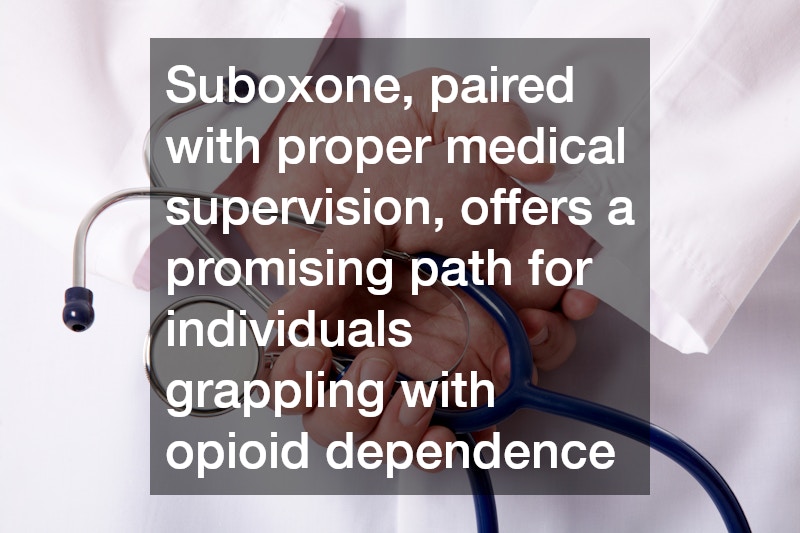When a doctor prescribes Suboxone, it marks a significant step in the journey towards recovery from opioid dependence. This medication, combining buprenorphine and naloxone, is used as part of a comprehensive treatment plan to help individuals manage cravings and withdrawal symptoms. Understanding how Suboxone works and what to expect can help patients navigate this form of medication-assisted treatment (MAT) more effectively.
In this post, we will delve into the key aspects you should be aware of, use “suboxone prescription” as a central term, and highlight the facts that can empower you during this crucial phase.
Understanding the Role of Suboxone
Suboxone plays a critical role in opioid addiction treatment by mitigating the painful withdrawal symptoms and reducing cravings for opioids. The primary component, buprenorphine, is a partial opioid agonist, which means it activates the opioid receptors in the brain but to a much lesser degree compared to full agonists like heroin or prescription opioids. This unique property diminishes withdrawal symptoms without producing the intense ‘high’ associated with opioid abuse. The addition of naloxone discourages misuse by causing withdrawal symptoms if the medication is injected, making the suboxone prescription a safe choice for many. This dual-action approach helps individuals to stabilize and work on long-term recovery strategies.
Importance of Medical Supervision
It is imperative that Suboxone is taken under strict medical supervision. Each patient’s response to Suboxone can vary, and doctors need to tailor dosages and monitor progress. Starting doses are generally low and may be adjusted based on how the individual reacts to the treatment. Regular follow-ups ensure that any side effects are managed promptly, and doses can be modified to optimize the treatment’s efficacy. Furthermore, medical professionals can provide valuable support and resources to help patients adhere to their recovery plan.
Side Effects and Considerations
As with any medication, Suboxone may come with side effects, although they are typically less severe than those associated with full opioid agonists. Common side effects include nausea, headaches, and mild constipation. It’s important to communicate any adverse reactions to your healthcare provider, as they can adjust your treatment accordingly. In some cases, Suboxone may interact with other medications, so it’s crucial to inform your doctor about all substances you’re taking. Being aware of potential side effects helps in preparing mentally and physically for the treatment, making the journey to recovery smoother.
Long-Term Treatment Plan
Suboxone is often just one component of a multifaceted approach to treating opioid addiction. Successful recovery usually involves a combination of medication-assisted treatment, therapy, counseling, and lifestyle changes. Behavioral therapy and support groups can complement the effects of Suboxone by helping patients build coping mechanisms and social support networks. Planning for long-term recovery goes beyond the initial treatment phase and requires ongoing commitment and adaptation. This holistic approach is vital for reducing the chance of relapse and achieving lasting recovery.
Myths and Misconceptions
There are several myths and misconceptions surrounding the use of Suboxone that should be debunked. Some people mistakenly believe that Suboxone simply replaces one addiction with another. However, when used correctly under medical supervision, Suboxone is a tool that can lead to independence from opioids. Another common myth is that Suboxone withdrawal is just as severe as withdrawal from other opioids, which is not the case for many patients. Educating yourself on the realities of Suboxone can enhance your confidence in the treatment and motivate you to stay the course.
Suboxone, paired with proper medical supervision, offers a promising path for individuals grappling with opioid dependence. By understanding its role, potential side effects, and its place within a broader treatment plan, those prescribed this medication can approach recovery with greater awareness and preparedness. While myths and misconceptions exist, they should not overshadow the potential benefits that Suboxone prescription, when correctly administered, can provide. Comprehensive support and continuous engagement with healthcare providers can significantly enhance the chances of successful recovery. This includes regular check-ins, mental health counseling, and access to peer support groups, all of which reinforce a patient’s commitment to sobriety. Additionally, education for both patients and their families can reduce stigma and promote a more compassionate approach to treatment. Recovery is rarely linear, but with the right tools, including Suboxone, individuals have a real chance to rebuild their lives. Ultimately, knowledge and commitment are key components in reclaiming one’s life from the grip of addiction and fostering long-term wellness and stability.
.






